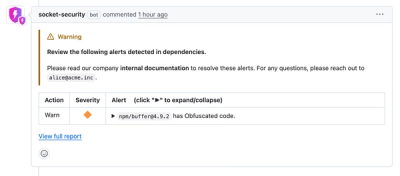
Security News
Crates.io Users Targeted by Phishing Emails
The Rust Security Response WG is warning of phishing emails from rustfoundation.dev targeting crates.io users.
github.com/open-telemetry/opentelemetry-collector-contrib/exporter/awsxrayexporter
| Status | |
|---|---|
| Stability | beta: traces |
| Distributions | contrib |
| Issues |   |
| Code coverage | |
| Code Owners | @wangzlei, @srprash |
This exporter converts OpenTelemetry spans to AWS X-Ray Segment Documents and then sends them directly to X-Ray using the PutTraceSegments API.
Trace IDs and Span IDs are expected to be originally generated by either AWS API Gateway or AWS ALB and
propagated by them using the X-Amzn-Trace-Id HTTP header. However, other generation sources are
supported by replacing fully-random Trace IDs with X-Ray formatted Trace IDs where necessary:
AWS X-Ray IDs in binary are 128 bits, the same size as W3C Trace Context IDs but the string is formatted to “1-{8 digit hex}-{24 digit hex}“. For example, The W3C format trace ID “4bf92f3577b34da6a3ce929d0e0e4736” is converted to the X-Ray format trace ID “1-4bf92f35-77b34da6a3ce929d0e0e4736".
The http object is populated when the component attribute value is grpc as well as http. Other
synchronous call types should also result in the http object being populated.
The following AWS-specific Span attributes are supported in addition to the standard names and values defined in the OpenTelemetry Semantic Conventions.
| Attribute name | Notes and examples | Required? |
|---|---|---|
aws.operation | The name of the API action invoked against an AWS service or resource. | No |
aws.account_id | The AWS account number if accessing resource in different account. | No |
aws.region | The AWS region if accessing resource in different region from app. | No |
aws.request_id | AWS-generated unique identifier for the request. | No |
aws.queue_url | For operations on an Amazon SQS queue, the queue's URL. | No |
aws.table_name | For operations on a DynamoDB table, the name of the table. | No |
aws.xray.annotations | The attribute is a slice(list) attribute that contains each of the string keys. If found on the span, the awsxrayexporter will use them in addition to the indexed_attributes configuration field when categorizing which attributes to index. This can be configured with "aws.xray.annotations"=["key1", "key2"] (Java example: span.setAttribute(stringArrayKey("aws.xray.annotations"), List.of("key1", "key2"))) | No |
Any of these values supplied are used to populate the aws object in addition to any relevant data supplied
by the Span Resource object. X-Ray uses this data to generate inferred segments for the remote APIs.
The following exporter configuration parameters are supported. They mirror and have the same effect as the comparable AWS X-Ray Daemon configuration values.
| Name | Description | Default |
|---|---|---|
num_workers | Maximum number of concurrent calls to AWS X-Ray to upload documents. | 8 |
endpoint | Optionally override the default X-Ray service endpoint. | |
request_timeout_seconds | Number of seconds before timing out a request. | 30 |
max_retries | Maximun number of attempts to post a batch before failing. | 2 |
no_verify_ssl | Enable or disable TLS certificate verification. | false |
proxy_address | Upload segments to AWS X-Ray through a proxy. | |
region | Send segments to AWS X-Ray service in a specific region. | |
local_mode | Local mode to skip EC2 instance metadata check. | false |
resource_arn | Amazon Resource Name (ARN) of the AWS resource running the collector. | |
role_arn | IAM role to upload segments to a different account. | |
external_id | Shared identitier used when assuming an IAM role in an external AWS account. | |
indexed_attributes | List of attribute names to be converted to X-Ray annotations. | |
index_all_attributes | Enable or disable conversion of all OpenTelemetry attributes to X-Ray annotations. | false |
aws_log_groups | List of log group names for CloudWatch. | [] |
telemetry.enabled | Whether telemetry collection is enabled at all. | false |
telemetry.include_metadata | Whether to include metadata in the telemetry (InstanceID, Hostname, ResourceARN) | false |
telemetry.contributors | List of X-Ray component IDs contributing to the telemetry (ex. for multiple X-Ray receivers: awsxray/1, awsxray/2) | |
telemetry.hostname | Sets the Hostname included in the telemetry. | |
telemetry.instance_id | Sets the InstanceID included in the telemetry. | |
telemetry.resource_arn | Sets the Amazon Resource Name (ARN) included in the telemetry. |
AWS X-Ray can be integrated with CloudWatch Logs to correlate traces with logs. For this integration to work, the X-Ray
segments must have the AWS Property cloudwatch_logs set. This property is set using the AWS X-Ray exporter with the
following values that are evaluated in this order:
aws.log.group.arns resource attribute.aws.log.group.names resource attribute.aws_log_groups configuration property.In the case of multiple values are defined, the value with higher precedence will be used to set the cloudwatch_logs AWS Property.
aws.log.group.arns and aws.log.group.names are slice resource attributes that can be set programmatically.
Alternatively those resource attributes can be set using the OTEL_RESOURCE_ATTRIBUTES environment variable. To set multiple log group names /log group arns, you can use &
to separate them. For example, 3 log groups log-group1, log-group2, and log-group3 are set in the following command:
export OTEL_RESOURCE_ATTRIBUTES="aws.log.group.names=log-group1&log-group2&log-group3"
This exporter follows default credential resolution for the aws-sdk-go.
Follow the guidelines for the credential configuration.
FAQs
Unknown package
Did you know?

Socket for GitHub automatically highlights issues in each pull request and monitors the health of all your open source dependencies. Discover the contents of your packages and block harmful activity before you install or update your dependencies.

Security News
The Rust Security Response WG is warning of phishing emails from rustfoundation.dev targeting crates.io users.

Product
Socket now lets you customize pull request alert headers, helping security teams share clear guidance right in PRs to speed reviews and reduce back-and-forth.

Product
Socket's Rust support is moving to Beta: all users can scan Cargo projects and generate SBOMs, including Cargo.toml-only crates, with Rust-aware supply chain checks.